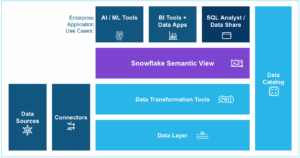
(Ociacia/Shutterstock)
When it comes to using AI to accelerate BI, practitioners are finding out that semantics really matters. In fact, when you’re using AI to generate SQL to query a database table, knowing exactly what data a particular table holds is absolutely a requirement. So-called semantic layers function as a sort of map that allows the natural language query to work. It’s not surprising, then, that a battle is breaking out over control of this semantic layer.
Before the age of AI, few people worried about semantic layers besides those in charge of implementing BI tools and modeling data in data warehouses. If your organization was adopting Tableau or Looker atop an analytic database from Oracle or Teradata, you would probably use the semantic tools associated with those BI products to define exactly how the “operating revenue” database view was developed, for example.
The semantic layer defines and enforces rules about data, such as what data sources can be used, what transformations are required, what checks must be performed. Your CFO would like to know that the “operating revenue” entry on her dashboard was calculated correctly–not just one time but every single time–and the semantic layer is a key piece of the analytics plumbing that ensured that happened.
Since ChatGPT ignited the AI revolution back in 2022, the semantic layer has experienced a renaissance. That’s due to the problem alluded to above: Letting language models lose on a database without a map of what the data means is a path to poor data, frustration, and business failure. Without a semantic layer to guide the language model’s access to data, it is almost guaranteed to make errors that will upset your CFO. That’s not something that you want to get in the habit of doing if job security is important to you.
The emergence of the humble semantic layer as a keystone in the AI-BI landscape has been occurring for the past couple of years. Vendors that developed semantic layers that exist independent of BI tools and allow organizations to standardize how their analysts interact with underlying databases, such as AtScale and Cube, have stepped up their development and marketing efforts to capitalize on the new demand. The folks at dbt Labs, developer of what’s arguably the world’s most popular data transformation tool, also launched their own semantic layer back in 2023.
Now the big dogs are starting to eat at the semantic buffet. Snowflake launched its semantic views feature during its recent Snowflake Summit 2025. Not to be outdone, Databricks launched its own take on semantic views, Databricks Unity Catalog metric views, at its Databricks AI & Data Summit 2025.
Snowflake Semantic Views
In its blog announcing semantic views, Snowflake engineers describe semantic views as “a new schema-level object that stores all semantic model information natively in the database.” It replaces the current Cortex Analyst YAML file, and provides an agreed-upon metadata standard for a range of Snowflake experiences, including AI-powered analytics, BI clients, Streamlit applications, Workspaces, Notebooks, and custom applications.
Snowflake provides analysts with several ways to create semantic views, including by using the Cortex Analyst UI, the database object explorer in Snowsight, or by writing a custom DDL statement. Snowflake says it has adopted a model definition language that lets users define the core attributes of a semantic view, which includes physical model objects (tables or views; SQL queries to be added in the future); relationships between these physical objects; dimensions (or business-friendly attributes that group and filter analytical queries); and metrics (or business-friendly calculations and aggregations that represent KPIs). Semantic views are currently in beta.
“We developed semantic views in response to a common customer need,” the Snowflake engineers wrote. “Customers want AI-powered conversational analytics but worry about ungoverned data access and inconsistent or inaccurate answers.”
Databricks Unity Catalog Metric Views
Databricks is doing something similar to its rival with its new Unity Catalog metric views. Unity Catalog, of course, is the centralized data catalog and data governance offering that helps customers manage access to data.
“Unlike metrics defined only in the BI layer, which limit reuse and integration, defining metrics at the data layer makes business semantics reusable across all workloads, like dashboards, AI models, and data engineering jobs,” Databricks writes in its June 12 blog post. “Unity Catalog Metrics are also fully addressable via SQL to ensure that everyone in the organization can have the same view of metrics, irrespective of what tool they choose.”
According to Databricks’ metric view documentation, metric views specify a set of definitions, including dimensions (such as product names or customer types) and measures (the acceptable values that summarize a business activity). Metric views are defined in YAML and registered in Unity Catalog; users can create them using SQL or the Catalog Explorer UI.
Metric views are governed and auditable by default, Databricks says. “Certified metrics come with auditing and lineage out of the box, enabling trusted, compliant insights across teams,” the company says. Users can create metrics once in Unity Catalog, and use them across multiple tools and experiences in Databricks, including AI/BI Dashboards, Genie, Notebooks, SQL, and Lakeflow jobs, the company says. In the future, Databricks say it will extend metric views to support BI tools like Tableau, Hex, Sigma, ThoughtSpot, and Omni, as well as observability tools like Anomalo and Monte Carlo, the company writes in its blog. Metric views are currently in beta, and are expected to be available later this summer.
Integrated or Independent?
There is clearly demand for a semantic layer, as Snowflake’s and Databricks’ moves into the product category demonstrate. Without this critical metadata layer, natural language query of business databases will remain an AI pipedream.
The big question seems to be whether there is enough momentum and demand for semantic layers to achieve escape velocity and become its own product category, independent of the BI products they were originally tied to, such as Looker and Tableau, or data platforms like the Snowflake and Databricks. The moves by Snowflake and Databricks suggest otherwise.
That’s not to say it could not happen. Higher up in the stack, that demand and momentum appeared for an independent table format to emerge: Apache Iceberg. Snowflake and Databricks laid down arms and decided to standardize on Iceberg, which was a win for customers and data independence and a loss for data lock-in and vendor greed.
Further down the stack, the semantic layer has similarly emerged as critical component for achieving data interoperability and bringing repeatability and reliability to AI-powered BI. Will the big dogs agree on a universal layer that benefits everyone, or seek to make semantic layers a competitive advantage? Time will tell.
Related Items:
Rethinking AI-Ready Data with Semantic Layers
Is the Universal Semantic Layer the Next Big Data Battleground?
Semantic Layer Belongs in Middleware, and dbt Wants to Deliver It



